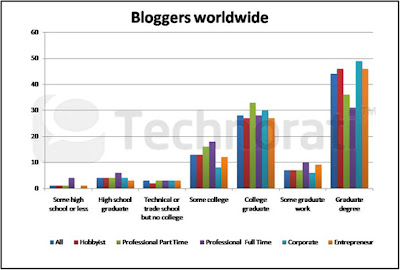In comparison to traditional media used widely such as print
ads, newspaper and television to get latest happenings or news to the public,
the occurrence of the blogging phenomenon has shifted the pedagogical approach
to sharing of information. In other words; the birth of blogs not only provides
up-to-date news and tidings but also gathers a community of involvement and
linkage to other members, as Branum explicates that blogs began to take new
shapes as the medium began to gain mass (2001).
From the data provided in Technorati’s State of Blogosphere 2011, the current size of the blogosphere is
constantly growing and the U.S deemed to predominantly spread to 50% of total
bloggers worldwide while Africa came with the least number of bloggers (2011).
 | ||
| Figure 1: The current size of bloggers worldwide (Technorati:State of Blogosphere 2011) |
 | ||
| Figure 2: Bloggers worldwide segmented via Demographics, education (Technorati: State of Blogosphere 2011) |
In
addition, the overall preference for a popular blog category constitutes to
mainly three types such as personal (includes personal topics), business (linkage
of professionals using WordPress to share expertise) and politics
(Wordpress.com, 2012).
One
of the benefits of these types of blogs is that it creates a Back
Link where it is possible to find future business partners as a result
of similar thoughts shared. Another benefit is it forms Real time discussion where
information received is usually before time of press releases and newspapers (A1 technology, 2010).
The first new media theory is the Multi-step flow theory
where it was originated from Paul Larzfeld elucidating that messages from the
mass media will first reach the opinion leaders who gradually filter the
information they gather to peers with whom they are influential (Griswold).
 |
Figure 3: Multi -step flow model
(Image source: http://nnlm.gov/evaluation/pub/bowes/, 1997)
Another theory that is relevant to the blogging phenomenon
is the Spiral of Silence theory. This theory exemplify that when facing a
controversial issue, the minorities will be “silent” from the fear of
separation and isolation if not agreeing to the majority’s perception (Neumann,
2011).
 | ||
| Figure 4: Neumann's Spiral of Silence Model |
(Image source: http://communicationtheory.org , 2011)
However, in my opinion this theory does not hold up as
societies today are changing their view front and are more particular about
what they think and the importance of freedom of speech. In comparison to the
U.S, for sure Malaysia’s socio-political scene haven’t changed that much but there
are still few (bloggers) that are eager to share their opinions despite the
limited freedom given.
REFERENCE LIST:
http://www.a1technology.com/book/benefits_blogging.htm
Bowes, J. E., 1997, “Multi-Step
Flow Model (image)”, National Network of Libraries of Medicine, Viewed at
24th March 2012
[Available Online]:
Branum, J. M., 2001, “The Blogging Phenomenon: An Overview and Theoretical
Consideration”, Southwest Texas State University, Viewed at 24th
March 2012 [Available Online]:
Griswold, S., “The Two-Step Flow of Communication Theory”, Apache Server, Viewed
at 24th March 2012
[Available Online]:
Neumann, E.N., 2011, “The
Spiral of Silence Theory”, Communicationtheory.org, Viewed at 24th
March 2012
[Available Online]:
[Available Online]:
No comments:
Post a Comment